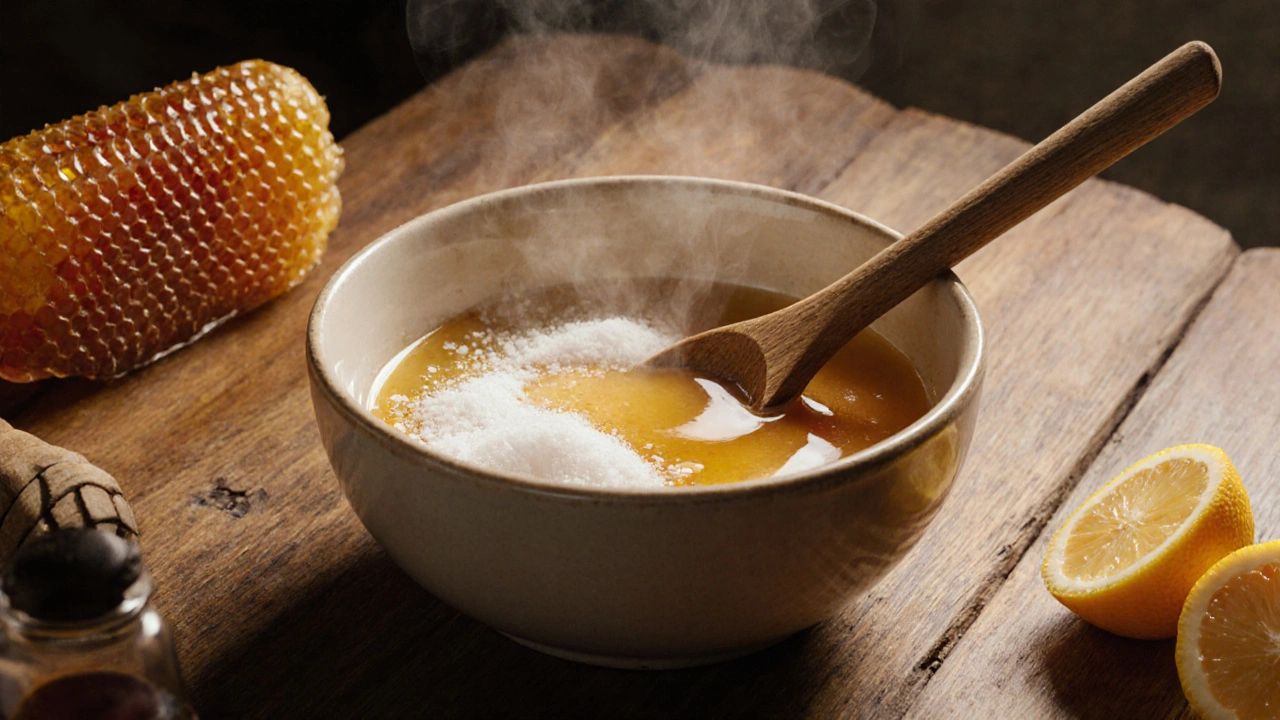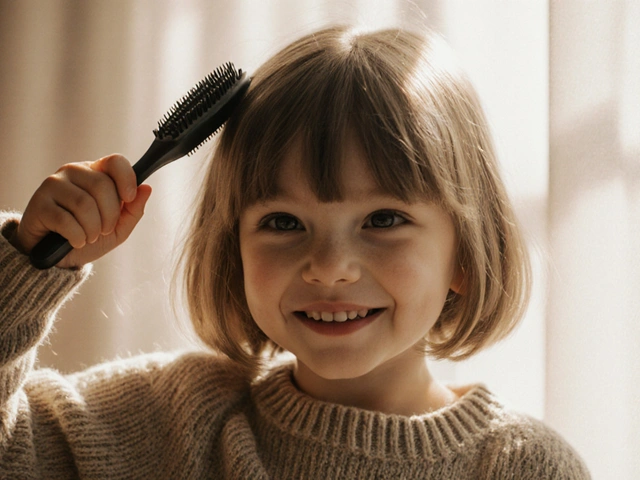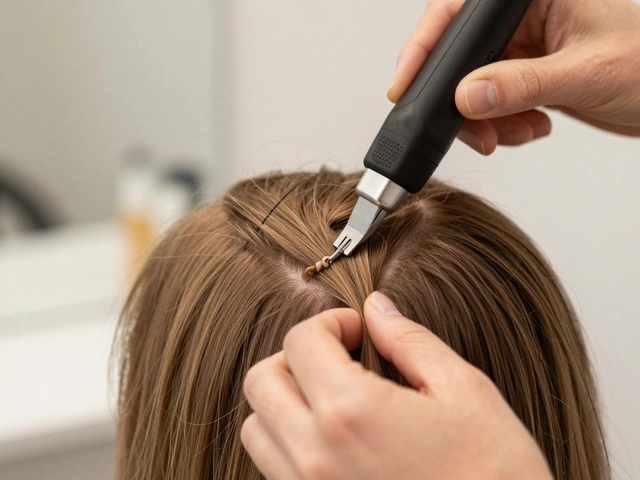Honey wax hair removal is a natural way to remove unwanted hair using a paste made mostly from honey, sugar, and lemon juice. Unlike traditional wax that contains chemicals and resins, honey wax is gentle, biodegradable, and often less irritating-especially for sensitive skin. It’s been used for centuries in Middle Eastern, Mediterranean, and South Asian cultures, and today, it’s a popular choice for people who want to avoid synthetic ingredients in their beauty routines.
How Honey Wax Works
Honey wax works the same way as other warm waxes: it’s heated until it becomes sticky and pliable, then spread over the skin in the direction of hair growth. A cloth strip is pressed on top and pulled off quickly against the hair direction, yanking the hair out from the root. The difference? Honey wax sticks to hair and dead skin cells but not as much to live skin. That’s because honey has natural adhesive properties that bond better with keratin (the protein in hair) than with moisture-rich skin.
This means less pain, fewer ingrown hairs, and less redness compared to chemical-based waxes. Many users report that after a few sessions, hair grows back finer and slower. That’s because consistent honey waxing weakens the hair follicle over time, making regrowth less noticeable.
What’s in Honey Wax?
Most homemade honey wax recipes use just three ingredients:
- Honey (raw, unfiltered): Acts as the base. Its natural sugars and enzymes help soften skin and reduce inflammation.
- Cane sugar: Provides the sticky texture needed to grip hair. White or brown sugar both work.
- Lemon juice: Lowers the pH, making the wax more effective and helping prevent bacterial growth.
Some commercial honey wax products add small amounts of natural oils like olive or coconut oil to make the paste easier to spread. But the core formula stays simple-no parabens, no petroleum, no synthetic fragrances.
Compare that to traditional strip wax, which often contains colophony (pine resin), synthetic polymers, and preservatives. These can trigger allergic reactions in people with sensitive skin. Honey wax doesn’t have those risks.
Honey Wax vs Regular Wax: What’s the Difference?
Here’s how honey wax stacks up against conventional wax:
| Feature | Honey Wax | Regular Wax |
|---|---|---|
| Main Ingredients | Honey, sugar, lemon juice | Pine resin, synthetic polymers, paraffin |
| Temperature | Warmer, but not scalding (100-110°F) | Hotter (120-140°F) |
| Adhesion | Binds to hair, not skin | Binds to hair and skin, causing more pain |
| Removal | Can be removed with water | Requires oil or remover |
| Skin Irritation | Low-often safe for sensitive skin | Higher-can cause burns or rashes |
| Environmental Impact | Biodegradable | Plastic-based packaging, non-biodegradable |
One big advantage of honey wax is cleanup. If you spill it on your counter or get it on your clothes, you can just rinse it off with warm water. Regular wax? You need special removers or rubbing alcohol-and even then, it’s messy.
Who Should Try Honey Wax?
Honey wax is ideal for:
- People with sensitive skin or eczema
- Those allergic to synthetic chemicals in commercial waxes
- Anyone looking for a more natural beauty routine
- First-timers who want a gentler introduction to waxing
- Parents looking for safe hair removal for teens
It’s also great for areas like the face, underarms, bikini line, and legs-anywhere you’d normally use strip wax. But it’s not recommended for very coarse hair like chest or back hair, where stronger formulas might be more effective.
People with diabetes or poor circulation should be cautious. Waxing removes hair from the root, and if your skin heals slowly, you risk infection. Always patch-test first.

How to Do Honey Waxing at Home
You don’t need a salon to use honey wax. Here’s a simple step-by-step guide:
- Prepare the wax: Mix 2 cups sugar, 1/4 cup honey, and 2 tablespoons lemon juice in a saucepan. Heat on medium, stirring until sugar dissolves. Let it boil without stirring for 5-7 minutes until it turns amber and forms a soft ball in cold water.
- Cool it down: Let the wax cool to 100-110°F. Test on your wrist-it should feel warm, not hot.
- Prep your skin: Clean the area with alcohol or witch hazel. Dust with cornstarch to reduce moisture.
- Apply: Use a wooden stick or spatula to spread a thin layer in the direction of hair growth.
- Strip: Press a cloth strip (cotton fabric works best) firmly over the wax. Hold the skin taut and pull back quickly in one motion.
- Aftercare: Apply aloe vera or coconut oil to soothe. Avoid sun, sweat, and tight clothes for 24 hours.
Most people see results for 3-6 weeks. Hair grows back slower with regular use.
Common Mistakes to Avoid
Even though honey wax is gentle, mistakes still happen:
- Applying wax too thick → Makes removal harder and more painful. Always use a thin layer.
- Using wax that’s too hot → Can cause burns. Always test temperature.
- Waxing over sunburned or broken skin → Risk of infection. Wait until skin heals.
- Not exfoliating beforehand → Leads to ingrown hairs. Exfoliate 24 hours before waxing.
- Waxing too often → Hair needs to be at least 1/4 inch long. Waxing too early = ineffective.
Also, never reuse wax strips. They collect bacteria and lose stickiness. Always use fresh cloth.
Where to Buy Honey Wax
You can make it yourself, or buy ready-made honey wax kits. Popular brands like GiGi, Nad’s, and Cirepil offer pre-made honey wax in jars. Look for labels that say "100% natural," "no additives," or "sugar-based." Avoid anything that lists "paraffin" or "resin" as the first ingredient.
Online retailers like Amazon or beauty supply stores carry them. Prices range from $15 to $30 per jar-enough for 4-6 full-body sessions.

How Often Should You Wax?
Most people wax every 3 to 6 weeks, depending on hair growth speed. For the bikini area or face, every 3-4 weeks is typical. Legs can go longer-up to 6 weeks.
Consistency matters. The more regularly you wax, the finer and sparser the regrowth becomes. After 3-4 sessions, many users notice they need waxing less often.
What to Expect After Waxing
Redness and slight swelling are normal for the first few hours. If it lasts more than 24 hours, you may have applied the wax too hot or too thick.
Small bumps? That’s usually ingrown hairs. Use a gentle exfoliating scrub 2-3 times a week after waxing. Avoid heavy lotions-they clog pores.
Some people report a faint honey scent after waxing. It fades quickly and is much more pleasant than the chemical smell of traditional wax.
Is Honey Wax Right for You?
If you’ve had bad experiences with waxing-burns, rashes, irritation-honey wax might be your solution. It’s not magic, but it’s simpler, safer, and kinder to your skin.
It’s also eco-friendly. No plastic pots, no chemical runoff, no synthetic waste. Just sugar, honey, and lemon-all things you might already have in your kitchen.
Try it once. You might find it’s the only hair removal method you’ll ever need.
Is honey wax better than sugaring?
Honey wax and sugaring are very similar-both use sugar-based formulas. The main difference is honey wax includes honey, which adds antibacterial and soothing properties. Sugaring paste is usually just sugar, water, and lemon. Honey wax tends to be stickier and adheres better to fine hair, making it slightly more effective for facial or underarm areas.
Can I use honey wax on my face?
Yes, honey wax is one of the safest options for facial hair removal, including eyebrows, upper lip, and chin. Its gentle formula reduces redness and irritation compared to chemical waxes. Always patch-test first, especially if you have acne-prone skin.
Does honey wax hurt less than regular wax?
Most people say yes. Because honey wax doesn’t stick as much to live skin, the pull is cleaner and less painful. The lower temperature also helps. That said, waxing still involves pulling hair from the root-it’s never completely pain-free, but honey wax makes it significantly more tolerable.
How long does homemade honey wax last?
Stored in an airtight jar at room temperature, homemade honey wax lasts up to 6 months. If you notice mold, a sour smell, or separation, throw it out. Always reheat gently and check temperature before use.
Can I use honey wax if I’m pregnant?
Yes, honey wax is generally safe during pregnancy. Hormonal changes can make skin more sensitive, so test a small area first. Avoid waxing the belly after the second trimester due to skin stretching. Always consult your doctor if you have complications.







Vishal Bharadwaj
November 11, 2025 AT 12:09honey wax? lol i tried it once and it felt like someone poured hot glue on my legs and then yanked it off with a pair of pliers. sure it's 'natural' but so is chewing on bark. also why does everyone act like sugar and lemon are magic? it's still waxing. same pain. just cheaper and messier.
anoushka singh
November 12, 2025 AT 20:02omg i love this! i’ve been using honey wax for 2 years now and my underarms haven’t been this smooth since i was 16 😍 also my mom makes it with jaggery instead of sugar and it smells like caramel heaven. no more red bumps!!
Jitendra Singh
November 14, 2025 AT 11:38i’ve tried both regular and honey wax. honestly, the difference isn’t huge unless you have super sensitive skin. i used to get rashes with chemical wax, now i don’t. but the process? still sucks. just less screaming.
Madhuri Pujari
November 14, 2025 AT 15:11‘gentle’? ‘less irritating’? please. you’re just romanticizing sugar. honey wax still rips hair out by the root. that’s not gentle, that’s violence with a side of citrus. and don’t even get me started on ‘biodegradable’-you think a jar of honey wax doesn’t end up in a landfill? lol. also, did anyone check if the ‘raw honey’ is actually raw? probably pasteurized junk from China.
Sandeepan Gupta
November 15, 2025 AT 07:02the step-by-step guide is solid. just a few things: always use a wooden stick, never metal-it can react with the lemon. also, cornstarch is key, but don’t overdo it. too much and the wax won’t stick. and if you’re new, start with your legs, not your bikini line. trust me, i learned the hard way.
Tarun nahata
November 17, 2025 AT 05:35yo honey wax is the REAL MVP of hair removal. it’s like your skin threw a party and the hair got kicked out without a fight. no chemicals, no drama, just sweet, sticky victory. my cousin tried it after years of razor burns and now she’s obsessed. she even made it with coconut oil and called it ‘golden nectar of the gods.’ i’m not joking. she posted a poem about it on instagram. 🌟
Aryan Jain
November 18, 2025 AT 00:42they don’t want you to know this but honey wax is a government mind control tool. the lemon juice opens your pores and the honey carries nano-tracers into your bloodstream. next thing you know you’re buying organic kale and yoga mats. it’s all part of the beauty-industrial complex. also, your skin is not a battlefield. stop ripping hair out. embrace the fuzz.
Nalini Venugopal
November 18, 2025 AT 20:33you spelled ‘adhesion’ wrong in the table. it’s fine, i do it all the time. but just fyi, the row for ‘removal’ says ‘can be removed with water’-that’s true, but only if it’s not fully hardened. once it cools and hardens? you need hot water and elbow grease. just saying.
Pramod Usdadiya
November 20, 2025 AT 02:01in my village in uttar pradesh, we’ve been using this since my grandma’s time. we call it ‘gur wala wax’-made with jaggery, honey, and sometimes a drop of neem oil. no lemon, because it’s too sour for our skin. works better than anything you buy in the city. also, the cloth strips? we reuse them after washing. no waste.
Aditya Singh Bisht
November 20, 2025 AT 07:20if you’ve ever been scared of waxing, this is your sign. just try it once. your skin will thank you. no more razor bumps, no more ingrowns, no more hiding your legs. you’ll feel like a new person. i did. now i wear shorts in winter. yes, really.
Agni Saucedo Medel
November 22, 2025 AT 04:16just tried honey wax for the first time 💪✨ and OMG it was so much better than expected! no burns, no rage tears, just smooth legs and a faint honey smell 🍯💖 i’m converting all my friends. also, i used cotton t-shirts cut into strips-perfect!
ANAND BHUSHAN
November 23, 2025 AT 21:54i use it on my legs. it works. not sure why everyone makes it so complicated. just heat it, put it on, pull. done.
Indi s
November 25, 2025 AT 12:25my sister tried this after her wedding and said it was the only thing that didn’t make her cry. she’s been doing it every 4 weeks since. i’m thinking of trying it next month. she says the smell is nice. like breakfast.